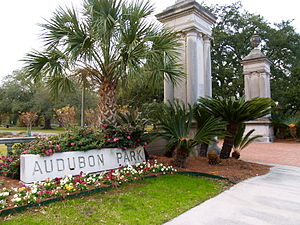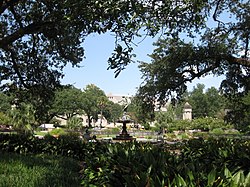Audubon Park (New Orleans)
| Audubon Park | |
|---|---|
 Audubon Park entrance located on St. Charles Avenue | |
 | |
| Type | Urban park |
| Location | New Orleans, Louisiana |
| Coordinates | 29°56′03″N 90°07′25″W / 29.93417°N 90.12361°W |
| Area | 350 acres (1.4 km2) |
| Created | 1871 |
| Status | Open all year |
Audubon Park (historically French: Plantation de Boré[1]) is a municipal park located in the Uptown neighborhood of New Orleans, Louisiana, in the United States. It is approximately 350 acres. The park is approximately six miles to the west of the city center of New Orleans and sits on land that was purchased by the city in 1871. It is bordered on one side by the Mississippi River and on the other by St. Charles Avenue, directly across from Loyola University and Tulane University. The park is named in honor of artist and naturalist John James Audubon, who began living in New Orleans in 1821.[2]
History and features

The land now housing the park was a
It was used by both the Confederate and the Union armies in the
Use as an urban park was intended from the start, with "Upper City Park" originally selected as a name to distinguish the park from
Early in the 20th century, part of the park became home to the Audubon Zoo. The zoo received significant improvement at the hands of the Works Progress Administration, and again from the 1970s onwards. Numerous early- and mid-20th century park attractions like the miniature railway, the enormous Whitney Young public swimming pool, the swan boats in the lagoons, and the carousel were closed, dismantled and/or discontinued in the 1970s, though a far smaller public pool was constructed in the 1990s adjacent to the site of the original Young pool.
The park features sports fields and picnic facilities along the Mississippi River, in an area called Riverview Park.[3] This riverside portion of Audubon Park is known colloquially as "The Fly",[4] an almost-forgotten reference to the modernist, butterfly-shaped river viewing shelter constructed in the 1960s and demolished in the 1980s in the aftermath of its severe damage one foggy morning at the hands of blundering river traffic.
The ring road around the park was closed to
A few of the park's old
Athletic facilities
In 1898 the Audubon
Wildlife

Ochsner Island on the east side of the park features a
References
- ^ "Cajun and Cajuns: Genealogy site for Cajun, Acadian and Louisiana genealogy, history and culture". www.thecajuns.com.
- ^ "John James Audubon". 25 October 2017 – via NYTimes.com.
- ^ "Audubon Park Map". Audubon Institute. Archived from the original on 2008-07-11. Retrieved 2008-07-13.
- ^ Saulny, Susan; McDonald, Brent (Producer) (2007). New Orleans Postcard (Streaming). New York Times. Retrieved 2008-07-13.
- ^ "David Berger – Avenger Field dedication". 10 June 2013.
